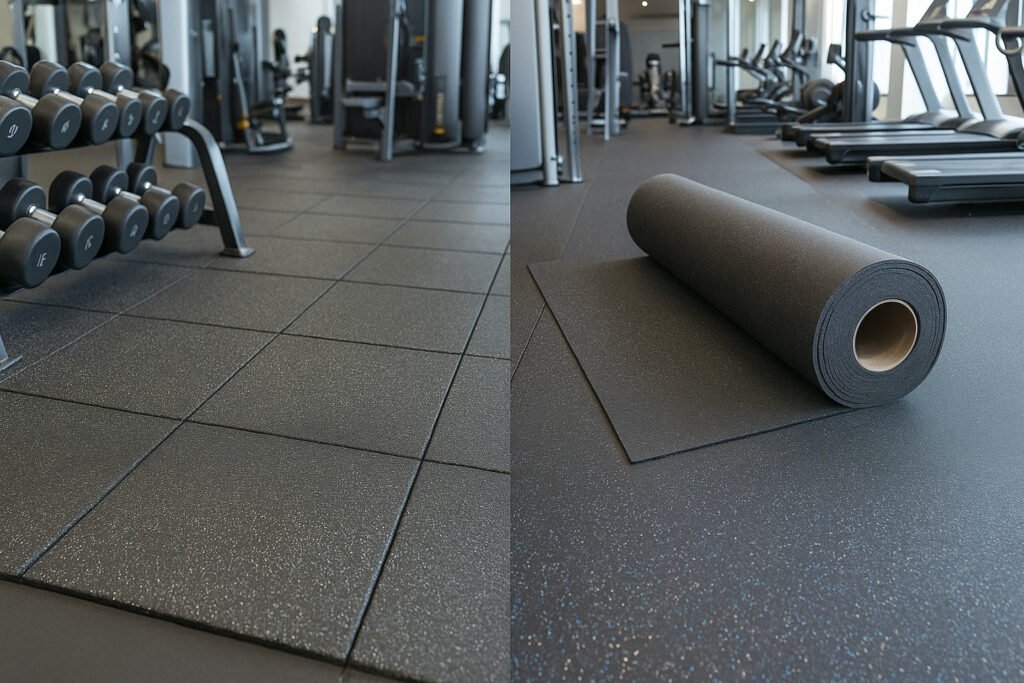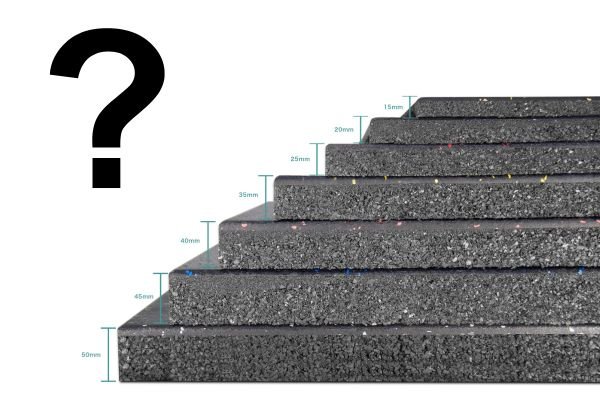Which Flooring Type is More Durable Under Heavy Use?
Your flooring isn’t just a finish—it’s part of your long-term cost control plan. For project managers, durability means fewer replacements, less downtime, and longer asset life.
Rubber tiles generally outperform rolls in impact-heavy areas due to higher thickness and compression resistance. Rolls are better suited for light to moderate wear zones.

In projects like gyms, schools, or public-use zones, choosing the wrong rubber flooring can lead to early wear, curling edges, and expensive repairs. If you manage specs, performance, and lifecycle budgets, here’s the breakdown you need.
Which Has Better Long-Term Wear Resistance?
Durability starts with material composition and continues with thickness and compression tolerance.
Rubber tiles offer better resistance to cuts, tears, and permanent compression—especially in high-traffic or drop zones.
Rubber Tiles: Built for Impact
Our tiny granule rubber tiles and composite tiles are commonly used in weightlifting zones and public entryways. Their key advantages:
- Available in 25–50mm thickness
- Compressed from 100% SBR or laminated with EPDM surface
- Designed for vertical impact and repeated use
Tiles don’t shift, stretch, or ripple like rolls can under load. They absorb shock and reset their shape even after repeated dumbbell drops.
Rubber Rolls: Best for Flex Zones
Rubber rolls are made from SBR or EPDM granules and are available in 3mm–12mm thickness. They are:
- Ideal for yoga, cardio, or transitional areas
- Easy to install and clean
- Not designed for heavy equipment loads
When overloaded or scratched by machinery, rolls can suffer edge curl or wear-through. Their surface is softer and intended for comfort, not industrial resistance.
| Factor | Rubber Tiles | Rubber Rolls |
|---|---|---|
| Material | Fine SBR / EPDM / Composite | SBR / SBR+EPDM |
| Thickness Range | 15mm–50mm | 3mm–12mm |
| Heavy Impact Resistance | ★★★★★ | ★★☆☆☆ |
| Durability in Drop Zones | Excellent | Low |
| Compression Set Recovery | High | Moderate |
| Ideal Use | Free weight areas, high-traffic paths | Cardio, yoga, office |
How Long Do They Last Under Daily Abuse?
Lifecycle matters. Project managers calculate ROI over years—not weeks.
Rubber tiles typically last 6–10+ years under heavy use, while rolls are better replaced every 3–5 years in active zones.
Tiles = High-Cycle, Low Maintenance
Thanks to their dense construction and edge integrity, puzzle tiles and full-block tiles:
- Resist peeling, tearing, and moisture ingress
- Are easy to replace one-by-one
- Maintain their surface grip even in dusty or oily environments
They are often certified under EN1177 or CE standards for high-abrasion and impact zones.
Rolls = Great for Soft Use, Shorter Life
Rubber rolls tend to:
- Flatten out under repeated rolling traffic
- Pick up scuffs and surface tearing
- Require full replacement if damaged (vs just swapping a tile)
They work best for spaces with soft-soled shoes or occasional use.
| Feature | Rubber Tiles | Rubber Rolls |
|---|---|---|
| Average Lifespan (Heavy Use) | 8–10 years | 3–5 years |
| Surface Grip Retention | Strong over time | Moderate |
| Spot Replacement | Easy (one tile) | Hard (cut + glue) |
| Edge Durability | High | Prone to curl |
What’s the Best Thickness for Durability?
There is no one answer—but for heavy use, thickness starts at 25mm and above.
Rubber tiles offer more thickness options and perform better at higher densities. Rolls are lighter and may compromise shock absorption.

Recommended Specs
| Zone Type | Recommended Product | Minimum Thickness |
|---|---|---|
| Free Weight Area | Tiny Granule Tile | 30mm+ |
| CrossFit Zone | Composite Tile | 25–40mm |
| Reception / Lounge | Rubber Roll | 6mm |
| Cardio / Yoga Studio | Rubber Roll | 4–8mm |
If unsure, we recommend combining tiles for heavy-use zones and rolls for light-use pathways to balance budget and performance.
Conclusion
For project managers working on high-traffic, high-impact zones—rubber tiles offer longer life, higher durability, and better performance under pressure. Rubber rolls are best for soft-use or transition spaces.
📂 Want to see our products in action? Explore real-world project examples
🌍 Need outdoor durability? Visit our Outdoor Rubber Floor
🎨 Customize shock-absorbing layers with EPDM Granules
Visit our main site for full catalog and specs.
